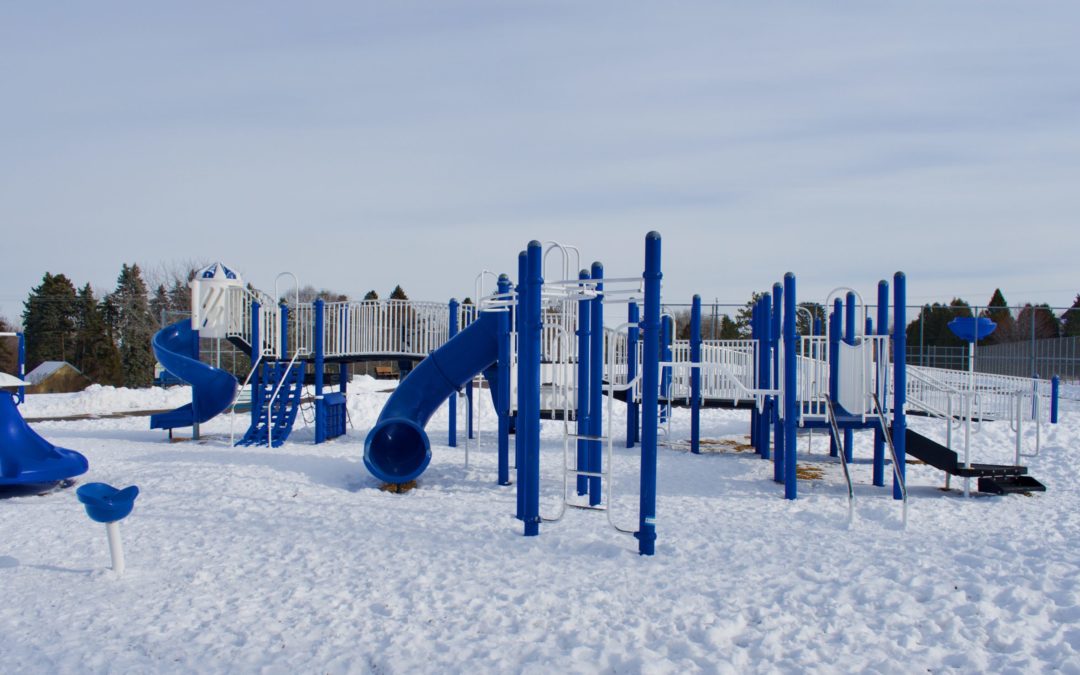Children and Students Are Still Using Playgrounds in Winter
The cold weather doesn’t stop students and local children from spending hours and hours on your playground. Since a majority of the school year is during the winter season, children rely even more on your playground to get outside during recess. It gives them a place to swing, jump, climb, and slide!
That’s why you need to continue caring for your playground through winter to provide a safe place for playing. With the Midwest’s harsh winters, regular maintenance inspections and repairs on your playground are obligatory because the snow and ice can quickly create unsafe and challenging conditions.
Common Playground Issues During the Winter Season
Because of the playground’s snow, ice, cold, and changing temperatures, your playground experiences a lot of severe conditions during winter. A few of the common issues playgrounds encounter during the winter and cold season include:
- Plastic components breaking
- Build up of snow
- Ice-covered ramps and walking areas
- Frozen playground surfacing
Risks of Neglected Playgrounds in Winter
The playground’s snow, ice, and cold cause common issues that can lead to hazardous conditions for children and students.
- Unsafe broken equipment
- Parts breaking while in use
- Slips and falls
- Limited accessibility for wheelchair users
- Liability concerns for schools and parks
4 Ways to Maintain Your Playground in Winter
1. Clear Playground Snow and Ice Regularly
We highly recommend removing snow and ice as soon as you can. By staying on top of your playground’s snow and ice, it will make it significantly easier to manage more downfalls and freezing temperatures as the winter progresses while removing the risk of slippery areas. It also can eliminate the need to use ice melt chemicals.
2. Use Ice Melt Chemical Cautiously
Ice melt chemicals are not only harsh on your playground equipment, but they are also unsafe for children. Kids are often crawling or rolling around on the playground or eating the snow. By adding ice melt to your playground, you risk your children or students touching or ingesting the chemicals. If you stay on top of removing playground snow and ice, you wouldn’t need to resign to chemicals for clearing ice-covered play areas.
3. Continue Your Regular Playground Safety Inspections
You should continue your usually scheduled safety inspections through the winter months. As mentioned, make sure to monitor all plastic components on your playground for signs of breakage, such as cracks or extreme wear and tear.
As the weather changes from warm to cool, it causes the ground to expand and shrink which impacts the foundation of the playground’s events. This causes the footers to heave and no longer be level. Your playground’s plastic components can’t withstand the pressure from the heaving which causes them to break.
It is important that when you repair these broken plastic components, such as slides, that you also reset and level the footer, or the part that is attached to the ground. If not straightened, it will again cause the same issue, resulting in a broken slide or plastic component that needs repair.
4. Monitor Ramps for Ice Build-Up
A common place for ice to become a problem on your playground is on the ramps. When they freeze, they become very slippery and hazardous. If your playground ramps are frequently coated in ice, we recommend using traction tape. It mitigates the likelihood of the ramp becoming slippery and reduces falls or slips.
How could you warm up a frozen playground?
As you maintain your playground in winter, an issue you may encounter is freezing surfacing. If your playground’s surfacing is frozen, it is most likely a result of poor drainage. As your playground fills with water, it will quickly freeze as the weather changes. Often this problem starts presenting itself during fall.
Frozen playground surfacing can quickly create an unsafe play area.
- Forms a hard and rigid surface
- Increases the risk of slips and falls
- Makes your surface non-compliant
To fix this issue, you must repair the root of the problem – your playground’s drainage system. It is not about how you can warm up a frozen playground, instead, it’s about removing the likelihood of frozen surfacing altogether.
Unfortunately, this means there is not much you can do about your frozen playground when it’s already frozen. Attempting to warm up or replace the surfacing will be very difficult during winter. Instead, what you can do now is start planning your new drainage system.
To limit your playground surfacing from freezing, your playground drainage system should:
- Quickly and effectively drain rain or other water sources
- Resist water pooling
- Flow water away from your playground
- Keep water from running into your playground
Keep Your Playground Safe This Winter Season
Give your students and children a safe place to play this winter season! We work with parks and schools to find the perfect maintenance plan and solutions that limit winter-related playground risks and protect children and your school or park. Contact our team, and let’s talk about how to take care of your playground this winter!

